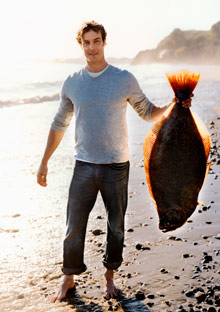Nice Catch!

Photo: Mikkel Vang
Even though we're big fans of seafood—go, fish!—most of us are still wondering what's safe, what's toxic, and what's about to be fished off the face of the planet. Celia Barbour dives into the matter of safety and sustainability and emerges with seven guidelines. And chef Barton Seaver hooks you up with some of the freshest, zestiest, most mouthwatering recipes around.
Used to be, a Gone Fishin' sign tacked on your door meant you'd shuttered up your cares for a day and ventured someplace remote and quiet to cast your line into the cool, bountiful deep. These days your cares are apt to come along for the ride. You reel in a flopping beauty but, hmm...perhaps you shouldn't eat it. It could be toxic with industrial contaminants, or maybe it's some drug-addled mutant escaped from an aquafarm. It could even be one of the last surviving members of an endangered species. But wait! At least you didn't kill any dolphins or loggerhead turtles while catching it, and besides, you do need to up your intake of omega-3s.
If you're confused about fish, welcome to the club. Everyone is confused about fish and seafood these days, even the experts. Marion Nestle, PhD, is a professor of nutrition, food studies, and public health at New York University and the author of What to Eat, a very smart book with five whole chapters devoted to shopping for seafood. She says, "For me personally, it's just way, way too complicated. I can't keep it straight."
But here's the catch: Just because it's okay to be confused doesn't mean you're allowed to be apathetic. You have to care about the seafood you eat. You just do. (And it's surprisingly easy to do the right thing, as you'll see shortly.) Because—remember passenger pigeons? Of course not. Nineteenth-century Americans ate them by the platterful, and look how that turned out: They're extinct. Unless you want to tell your grandchildren that you blithely gobbled up the last remaining members of a magnificent species, you should avoid certain fish and crustaceans altogether, at least until their populations recover—bluefin tuna, for example, which you may know as toro at the sushi bar, and which is wobbling on the brink of total obliteration.
Reel In or Throw Back?
A few well-informed consumers can make a huge difference by putting pressure on providers to alter harmful practices. Here are seven smart choices you can make right now:
- Carry a fish list. These wallet-size cards rank more than three dozen types of seafood in order from best choices to worst in terms of both health and sustainability. They are published by the Environmental Defense Fund (edf.org), the Monterey Bay Aquarium (mbayaq.org), and the Blue Ocean Institute (blueocean.org); you can download a list from their Web sites. The Natural Resources Defense Council, meanwhile, publishes a comprehensive guide to sushi (nrdc.org). And if you're a parent, check out kidsafeseafood.org for the best options for growing bodies.
- Eat low on the food chain. Smaller fish—sardines, anchovies, farmed trout, fresh tilapia, arctic char—and bivalves such as scallops, clams, and oysters don't build up as many contaminants as do the large carnivores. Small fish also reproduce quickly, so their populations can recover from overfishing much more easily than the long-lived giants. "This is the best general rule of thumb," agrees Carl Safina, PhD, author and founding president of the Blue Ocean Institute, an advocacy group, "because the larger the fish grow to be, the more likely they are to be both depleted and carrying a higher load of chemicals." Limit your consumption of predator fish to no more than once every two weeks.
- Diversify your seafood diet. The broader the variety of crustaceans, bivalves, and fish you eat, the more you'll reduce your exposure to any one contaminant and ease the pressure on a particular species.
- Look for the Marine Stewardship Council stamp of approval. This independent certification organization sends its detectives around the world to examine wild-capture fisheries. They give their label only to the leading lights in the field. A list of retailers carrying MSC-certified seafood can be found at eng.msc.org.
- Buy Alaskan. "As a gross generalization, Alaska has the best-managed fisheries of any region in the world," says Safina. "They took a banking approach to fishing: Live only off the interest and preserve the capital." Today their wild seafood populations are healthy in every sense of the word. Look for Alaskan salmon, halibut, and sablefish, and consider replacing half the canned tuna in your diet with canned Alaskan salmon.
- Try something new. The next time you visit a restaurant, order an unfamiliar fish. "You aren't going to go into a grocery store and buy something you've never tasted before," says Barton Seaver. "At a restaurant, entertainment is part of what you're paying for. There are hundreds of species of edible seafood, but most restaurants offer only ten or 12, tops. By making something unfamiliar taste good, chefs can sell a solution."
- Avoid farmed atlantic salmon for now, but don't write off aquaculture outright. Farmed freshwater fish such as catfish, barramundi, and trout and bivalves such as oysters and clams are among the best choices available. And Kona Kampachi, a type of yellowtail, is being raised sustainably on innovative open-sea farms off the coast of Hawaii. With virtually no contaminants, it's a smart alternative to wild tuna.



